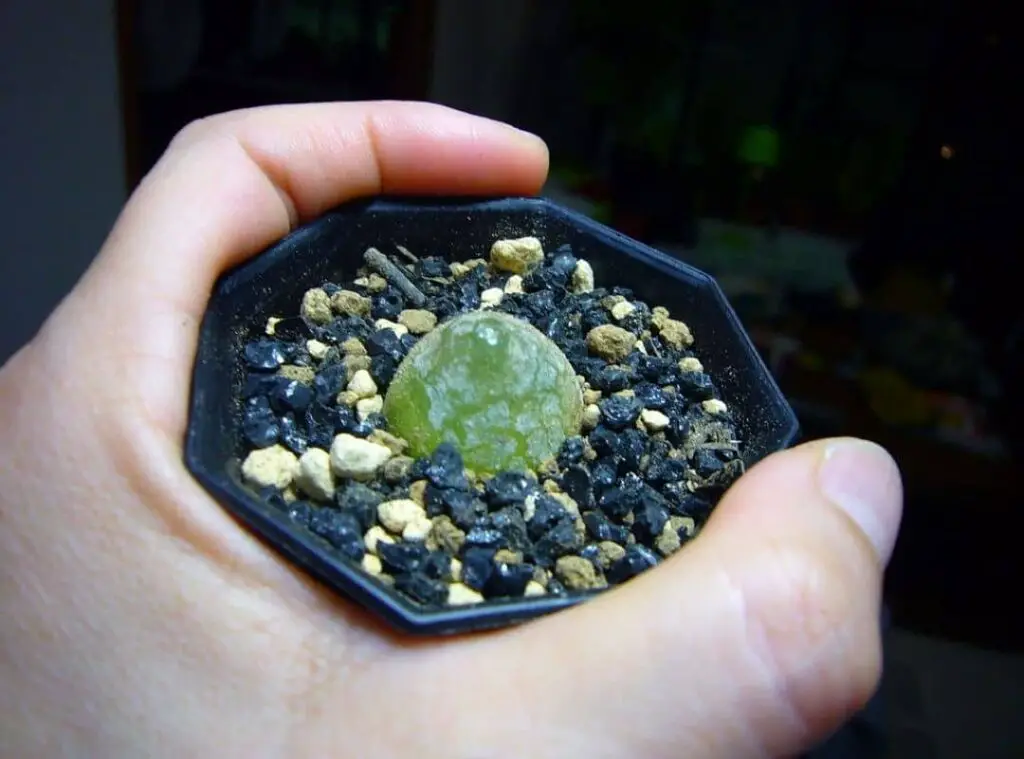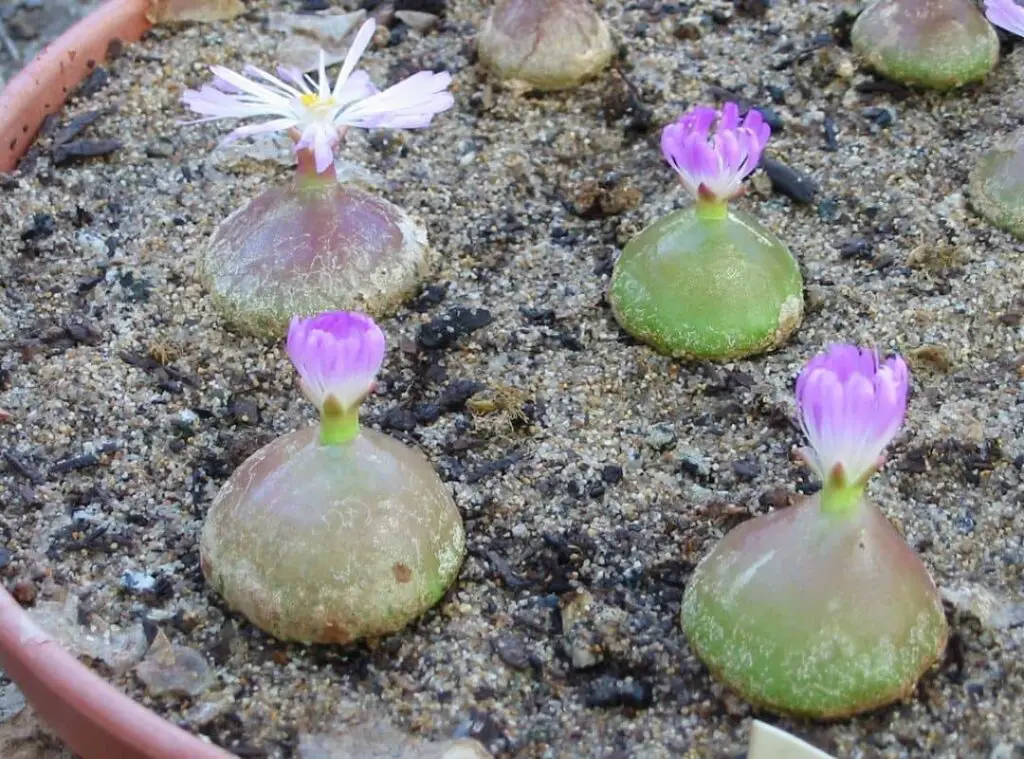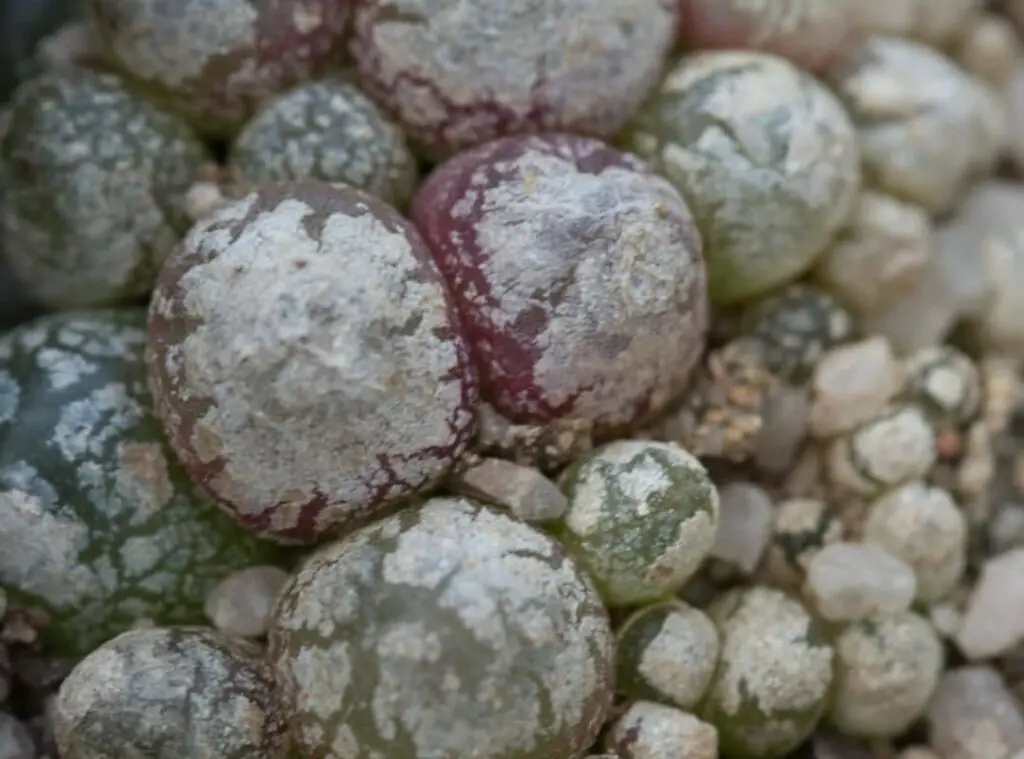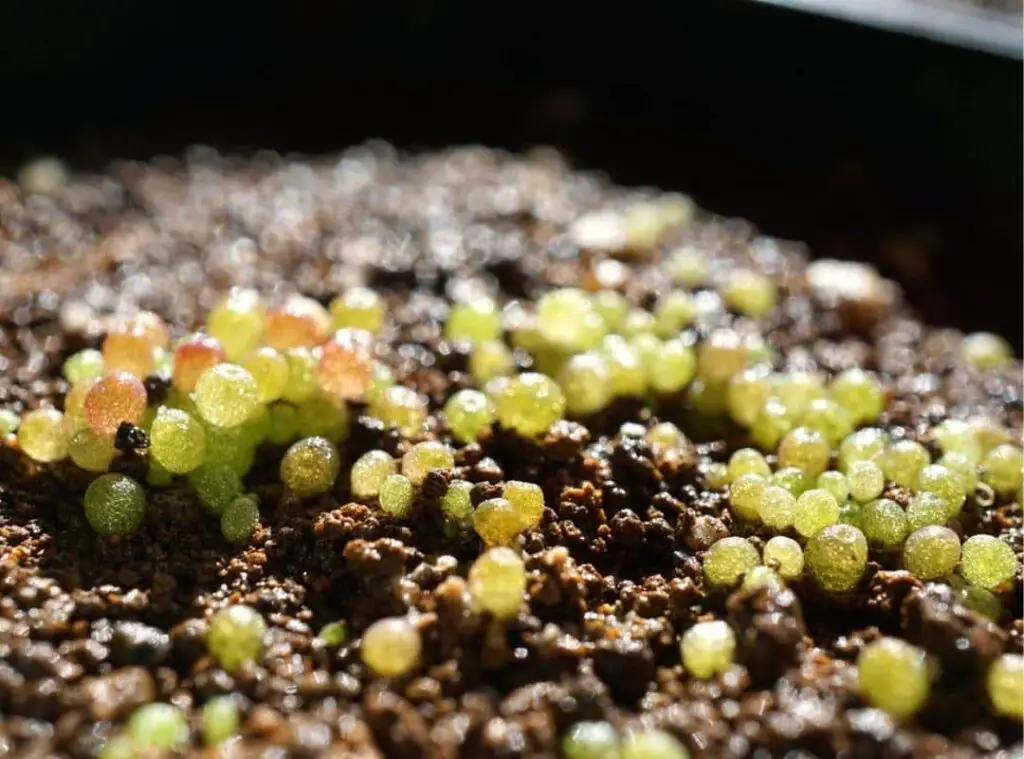Conophytum burgeri (Burger’s onion) is a fantastic and unique plant you would come across in the cactus and succulent world. In fact they look like a burger.
Conophytum burgeri is an endemic plant to South Africa. Conophytum burgeri belongs to the genus Conophytum.
It could possibly be one of the most unusual yet most attractive species of the genus conophytum.
This is considered a plant which is under extinction. It is tiny and consists of onion shaped leaves.Thus, they are called Burger’s onion.
So, if these facts have made you excited to own one of these beauties and wondering how to look after them well, keep reading this article as I am going to cover all the necessities you need to fulfil.

How do I identify Conophytum burgeri?
You could identify the Conophytum burgeri by looking at their plant’s foliage. Their prominent color is strawberry color.
You could spot them in clumps along with four to five heads. They are actively growing in spring and in summer.
Their foliage look like an onion. Further their sizes would be about 2.5 cm (1 inch) in diameter.
Apart from that you could identify these plants from their flowering activity too. They would usually produce flowers in purple during spring.
They would be so pleasing to look at, particularly if you have grown them in cute looking pots. Those flowers would arise from the center of the plant.
Conophytum burgeri consist of a small fissure in their body. They further consist of a smooth epidermis. It is shiny and translucent and light green in color.
However you could spot them in purple as well. They are a slow growing set of plants, and they will tend to form in two to three heads as they grow older.
One look care guide
| Botanical Name | Conophytum burgeri |
| Common Name | Burger’s onion |
| Plant Type | Cactus / Succulent |
| Mature Size | 2.5 cm (1 inch) in width. |
| Sun Exposure | Full sunlight to partial sunlight |
| Soil Type | Well-draining |
| Soil pH | Neutral |
| Bloom Time | Spring |
| Flower Color | Purple |
| Hardiness Zones | USDA hardiness zones 10b-11b (1.7 degrees Celsius ). |
| Native Area | South Africa |
| Toxicity | Non toxic |
| Average price | $ 8 |
How do you take care of Conophytum burgeri?
Light Requirement
Conophytum burgeri require full sunlight to partial sunlight for their vigorous and firm growth which is more like the rest of other succulents.
Make sure you do not leave them exposed to intense sunlight. I encourage you to place them in a shady place during extremely heated times especially during summer.
On the other hand, they would prefer to be in full sunlight in the morning hours as the morning sunrise is not that harsh.
Once you adhere to these care tips, it will avoid any potential sunburns in the plants.
Temperature and humidity
Conophytum burgeri would thrive well in a temperature range of 15 degrees Celsius (59 degrees Fahrenheit) and 20 degrees Celsius ( 68 degrees Fahrenheit).
On the other hand, ensure that you do not expose them to temperatures below 5 degrees Celsius.
The minimum temperature Conophytum burgeri could withstand during the night is 5 degrees Celsius (41 degrees Fahrenheit) to 10 degrees Celsius (50 degrees Fahrenheit).

Is it cold hardy?
Conophytum burgeri are not cold hardy plants.
USDA hardiness Zone
Conophytum burgeri are hardy in USDA hardiness zones 10b-11b (1.7 degrees Celsius (35 degrees Fahrenheit).
Watering Requirement
Watering Conophytum burgeri well is quite important when taking care of them properly.
Simply you may continue with the regular succulent watering caring tips when watering these plants as well.
Succulents in general do not prefer to be in soggy and damp conditions and Conophytum burgeri are not different to them.
As such ensure that you water them adequately without watering them in abundance.
Conophytum burgeri need only a minimum watering level to survive. If you end up watering them in excess, it will make the epidermis break which will ultimately result in unsightly scars which would lead to rot later on.
You could water them less often during the entire year. However, you could cease watering them in winter or water them lightly if you spot they have shriveled.
When you water the Conophytum burgeri during spring and summer, ensure the soil is dry. After that only you could resume watering them.
Soil Requirement Type / pH
It is important that you grow them in a porous soil mix which is fast draining.
When you go ahead with a well-draining soil mix, it will ensure that no excess moisture is retained in the pot.
When you use a porous soil mix, it will make sure that there is a good aeration in the soil mix too.
Flowering and Fragrance
Conophytum burgeri produce flowers in spring. Further they would be purple in color.

Pot size Potting and Repotting
Conophytum burgeri would prefer a shallow pot to thrive well.
These are slow growing plants, and you could let them be in the same pot for years. Further do not go ahead with larger pots as the flowering of the plant will be badly affected by it.
Instead, proceed with small individual pots which have sufficient draining holes as well.
If you wish to repot them, you could do it once every two to three years. Further you could consider repotting them once you freshly purchase them from the stores as well.
Most of the times, Conophytum burgeri could have been grown in low quality soil mixes and hence best is to repot them in a fresh soil mix and give them a new start.
If you keep growing them in the same pot, nutrients will be depleted, and it is important you repot them so that the plants can gain nutrients freshly.
Where to Plant
Strong lighting levels are quite crucial when selecting the right place to plant the Conophytum burgeri. As such, if you wish to plant them in a garden, you could select a bright sunny spot to grow them.
You could grow them ideally outdoors rather than growing indoors since they require plenty of sunlight to survive.
Conophytum burgeri are fond of growing in warmer temperature conditions. Hence, if you are someone who lives in USDA hardiness zones 10b-11b, you could grow them outdoors.
If you live in colder areas than that, best is to grow them as indoor plants.. However, if you grow them as indoor plants, ensure that you fulfill the sunlight requirement.
Further you need to grow them in a porous material pot as well.
Fertilizer and time of year
Conophytum burgeri do not depend on fertilizers a lot. However, you could consider feeding them once in their growing season.
You may go ahead with a balanced fertilizer when feeding them. However, I encourage you to dilute it to half a strength and then use it.
Do not feed them during winter as they will be dormant during winter.

Dormancy
Conophytum burgeri will go dormant during winter.
Can be toxic to pets
This is a non-toxic succulent.
Common bugs and illnesses
Conophytum burgeri could encounter mealybug attacks quite often.
Apart from that, they may also come across root rot if you water the Conophytum burgeri in excess.
However, if you have grown them in a well-draining soil mix and if your soil mix has a good aeration, it is very unlikely that you will go through root rot.
Special Care tips
Conophytum burgeri could thrive well with a minimum supervision from you.
All you need to do is to water them well, expose them to strong sunlight levels and grow them in a well-draining soil mix.
Furthermore, if you live in colder areas and if you have placed the plants outdoors, you could bring them indoors to protect it from frost damage.
How to propagate Conophytum burgeri
You may propagate the Conophytum burgeri by its seeds. Once their flowers produce seeds, you can let those seeds germinate by soaking in the water.
After they produce roots you can place rooted seeed in a growing medium and grow them slowly.
You only have to sow them in a well draining soil mix.

Conophytum burgeri plant benefits
Conophytum burgeri could be handy as indoor plants. In addition to that they would look great in cute looking pots and you could consider placing them as patio plants and as outdoor plants too.
Read More : Conophytum Propagation Guide | 4 Effective Ways To Propagate | 16 Care Secrets For Your Amazing Conophytum Maughanii Succulent 17 Conophytum Bilobum (living pebble) Care Secrets For You
